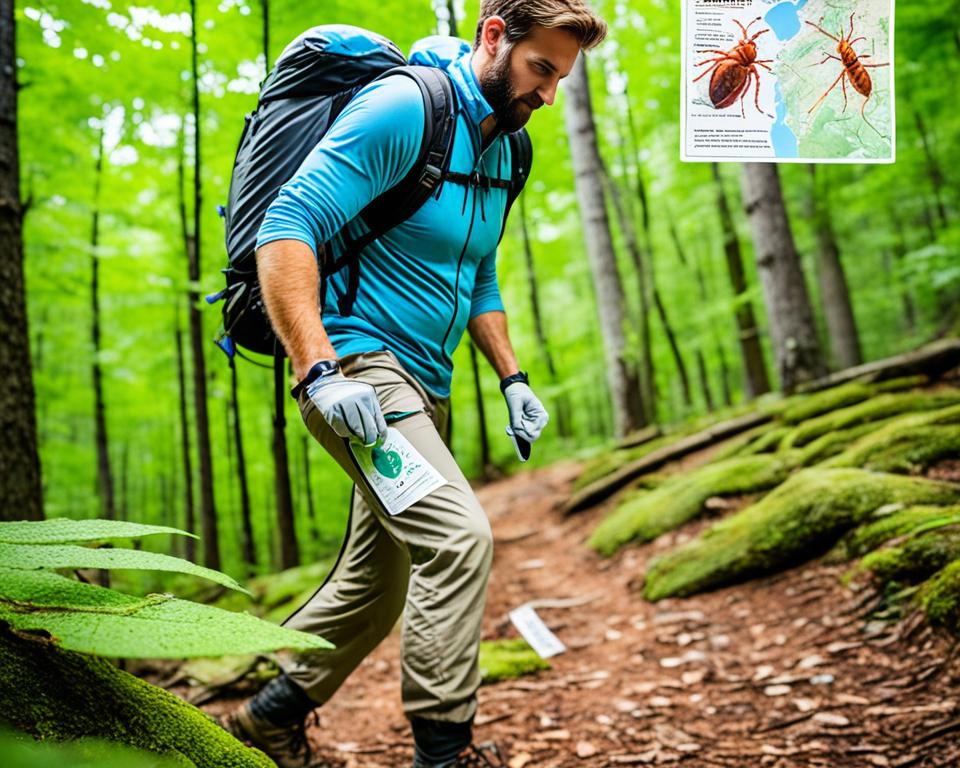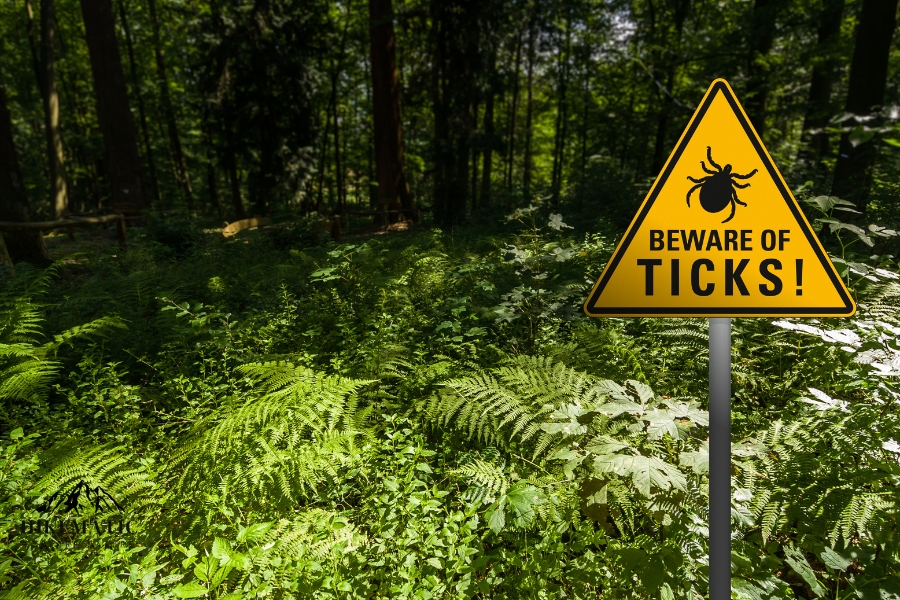I went on a hike in the beautiful Shenandoah National Park over the weekend last summer. The air smelled like pine, the sky was clear, and the trail was calling. But about halfway through my hike, I felt a painful pinch on my leg. A tick was already digging in when I rolled up my pants, which caught me off guard.
By spreading Lyme disease, Rocky Mountain spotted fever, and other diseases that ticks spread, ticks can make a pleasant hike dangerous for your health. The Centers for Disease Control and Prevention (CDC) stress how important it is to avoid ticks in order to lower these risks.
Both the blacklegged tick, also known as the deer tick, and the lone star tick are prevalent in the US and have the potential to transmit dangerous diseases. Adopting tick-free practices makes the outdoors safer, so knowing and using preventative measures is important for the health of all hikers.
Since then, I’ve learned a lot about how to hike without getting ticks. Not only has it been important for my health, but also for my peace of mind. This is what I’ve learned.

Understanding the Risk of Ticks
Ticks are very bad for your health. Many people are concerned about Lyme disease and Rocky Mountain spotted fever. These diseases, spread by ticks, can be very bad. Blacklegged ticks, which carry Lyme disease, and Rocky Mountain wood ticks, which carry Rocky Mountain spotted fever, prefer to live in areas with lots of trees and tall grass.
Ticks often attach to people and pets that walk through these areas. It’s important to know where ticks like to live and when they’re most active. The CDC says that people are more likely to get sick when they are outside, so it’s important to be careful. Taking steps to avoid getting tick-borne diseases is easier when you know the risks and stay informed.
It’s important to understand the landscape. The blacklegged tick, which is common in the US, is very dangerous. It’s fun to be outside, but we need to watch out for these small but dangerous animals. By being aware of the risks and taking precautions, you can lower the chances of getting diseases from ticks, making your time outside safer.
Choosing the Right Clothing
While hiking can be enjoyable, it’s crucial to prepare to prevent tick bites. Putting on the right clothes is a big part of staying safe from tick bites.
Wear Long Sleeves and Long Pants
Putting on long sleeves and pants is one of the easiest ways to keep ticks from biting you. The CDC stresses that wearing clothes that cover your skin makes you much less likely to get ticks. The American Hiking Society also says that you should tuck your pants into your socks to make an extra barrier against ticks. Doing this will help keep ticks off of your body for a long time.
Opt for light-colored clothing.
Another effective strategy to prevent tick bites is to wear light-colored clothing. Outdoor experts say this is a good idea because it makes it easier to see ticks before they get on your skin. If you don’t want to deal with bug bites on your hike, wearing long trousers and light-colored clothes can help.
Using effective insect repellents
It’s not enough to wear the right clothes to stay tick-free while hiking; you also need to use the right bug spray. To keep those annoying ticks away, you might want to add a good insect repellent to your outdoor activities. Experts say the oils of lemon eucalyptus and DEET are two good options.
DEET
It’s known that DEET keeps bugs away, and the Environmental Protection Agency (EPA) says it works. As long as you put DEET close to your skin or on your clothes, ticks will stay away. A lot of hikers choose DEET because it works well and keeps them safe on long hikes.
Oil of Lemon Eucalyptus
The oil of lemon eucalyptus is a great choice if you want something more natural. The EPA also recommends it for its effective tick-repelling properties. People who want an alternative to synthetic insect repellents are becoming more interested in this plant-based one. Wearing it close to your skin will protect you while hiking.
Oil of Lemon Eucalyptus

Avoiding Tick-Infested Areas
It’s important to know where ticks are likely to be when you go hiking. If you want to stay away from ticks, the CDC says it’s simple: stay away from wooded and bushy areas, especially ones with lots of tall grass and leaf litter. This is very important if you want to stay away from tall grass, where ticks love to live.
Stick to the middle of trails to avoid going through areas where ticks are common. This is a very important way to stay away from ticks because it keeps you from touching the tall grass and leaves where ticks like to hide. Also, be careful about things like brushing against branches or sitting on logs, which can make you more likely to get ticks.
Dealing with a Tick Bite
If you find a tick on your body, you need to act quickly to avoid getting an infection. Pathogens like Lyme disease can be less likely to spread if you act right away.
Find a Tick Immediately
First, look all over your body carefully to see if you can find a tick. Pay extra attention to areas where ticks like to hide, such as under your arms, behind your knees, and on your head.
Removing a tick
It is necessary to use fine-tipped tweezers to remove a tick. Grab the tick as close as possible to the skin’s surface. Keep the pressure on even as you pull up. Avoid twisting or jerking to prevent the tick’s embedded parts from breaking off.
After getting rid of the tick, it’s important to clean your bite area and hands. To clean the area, you can use rubbing alcohol, an iodine scrub, or soap and water. This simple tick bite action can help keep you from getting an infection and help you heal faster.
By following these steps, you can effectively treat tick bites and lower your risk of complications. Be alert and ready to make your hiking trip safer.

Post-Hike Precautions
Your journey to safety isn’t quite over yet, even though you had a great hike. It’s crucial to go above and beyond to prevent ticks.
Check your equipment and pets.
First, always check your gear for ticks. Ticks are quick to attach to your backpack or other gear. Do a full check on your pets and any ticks they may have picked up along the way. After riding on your pets, it doesn’t take long for ticks to get into your home.
Shower Soon After Hiking
Take a shower as soon as possible, preferably within two hours after your hike. This is another important safety measure. When you shower, you can check your whole body for ticks and get rid of any that aren’t attached. By acting quickly, you can stop any ticks from biting and spreading diseases.
Taking these safety steps after hiking will not only make sure you have a great hike but also a healthy, tick-free trip back home.
In conclusion
You need to be aware of ticks and take steps to avoid them while hiking. We can better get ready for our outdoor adventures if we know what the risks are. Utilizing all of our resources to prevent tick bites is critical because diseases like Lyme disease, which ticks spread, are a real threat.
With the right clothing, such as long sleeves and light colors, we can see ticks before they become a problem. Another important thing to do is use effective insect repellents like DEET or lemon eucalyptus oil. These steps make sure that we’re doing everything we can to avoid ticks outside.
Q&A
What are some ways to avoid ticks while hiking?
When I go hiking, I always stay on well-kept trails, wear long sleeves and pants, and use an effective bug spray like DEET or the oil of lemon eucalyptus to keep ticks away. The CDC also says to stay away from tall grass and leaf litter, which are common places for ticks to live.
Why is it important to wear light-colored clothing when hiking?
You can see ticks better before they attach to your skin if you wear light-colored clothes. Ticks are usually dark, so light colors make them stand out more. This lets me get rid of them before they bite.
What are common tick-borne illnesses I should be aware of?
Ticks spread Lyme disease, Rocky Mountain spotted fever, and other diseases to many people. Lyme disease can spread through Blacklegged ticks, also known as deer ticks. Rocky Mountain wood ticks, on the other hand, have the potential to spread Rocky Mountain spotted fever.
What type of insect repellent should I use to prevent tick bites?
I recommend using bug sprays containing DEET or lemon eucalyptus oil. Both are effective at keeping ticks away. Just follow the instructions on the label to use it the right way.
How can I avoid tick-infested areas while hiking?
To avoid ticks, I stay in the middle of trails and don’t go into areas with tall grass or lots of leaves on the ground. The CDC recommends taking these steps to limit your exposure to tick-prone areas.
What should I do if I find a tick on me?
If I find a tick, I use fine-tipped tweezers to get rid of it right away. I grab the tick as close to the skin’s surface as I can and pull it up slowly and evenly. After taking it off, I use rubbing alcohol, an iodine scrub, or soap and water to clean the bite area and my hands.
What are the post-hike precautions I should take to avoid tick-borne diseases?
I always look for ticks on my gear and pets after a hike. I shower after two hours to remove any unattached ticks and to thoroughly inspect my entire body for ticks. By taking these precautions, you can greatly lower your risk of getting tick bites and the diseases that come from them.

